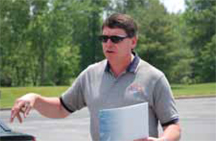
| Monday, July 01, 2013 | Archives | Advertise | Online Buyer's Guide |
The NAFA Staff Takes The Wheel
 NAFA Database & Membership Manager Maureen Smith and NAFA Education Assistant Kate Shelko Under the direction of NAFA Affiliate Phil Moser, Vice President of Advanced Driver Training Services Inc. (ADTS), the regular tasks of the NAFA Staff were suspended for a day-long driver training course followed by a road test on May 29. The training session was made mandatory with the first day devoted to the individual staff and a second full day given over to family of the staff for a duplicate course. "When I was discussing having this with Phil (Moser), it made so much sense to try to get everyone we could into this training," NAFA Executive Director Phil Russo, CAE said.  Moser, a former suburban Philadelphia police officer and a crash investigator, started the presentation with some purposefully provocative statistics. "$230.6 billion dollars were spent on crashes (in 2012). That comes up to around $820 per citizen, at a cost of $99 billion dollars in medical costs and lost productivity. Moser, a former suburban Philadelphia police officer and a crash investigator, started the presentation with some purposefully provocative statistics. "$230.6 billion dollars were spent on crashes (in 2012). That comes up to around $820 per citizen, at a cost of $99 billion dollars in medical costs and lost productivity."There were 34,080 crash fatalities in 2012, averaging about 94 fatalities each day," Moser continued. "When we break that down, that is one crash every five seconds, one critical injury every ten seconds, and one fatality every fifteen minutes. Now what that means to you is that one-in-fifteen people will be in a collision this year, one in 45 will suffer an injury in a crash, and one-in-65 will die in a fatal crash. The driver controls the risk factors, and we can do much, much better than we are." Moser and fellow ADTS trainers Chris Carlile and Mark Troutman escorted the staff to the parking lot of the Montgomery Evangelical Free Church in Belle Mead, NJ, where three separate road tests were mapped out with orange traffic cones. The first, a braking course, was designed to teach "threshold braking," or to get the feel of applying the brake in a speed situation that doesn’t engage the anti-lock brakes. The benefit of this technique is that threshold braking allows the driver to retain control of the wheel and to swerve out of a dangerous event (known as "controlled avoidance").  The second test, the crash avoidance course, simulated an obstruction in the road and tests the driver’s ability not only to steer past it, but to snap the wheel back into position to stay on the road, and not veer off into the side of the road or into more traffic. The second test, the crash avoidance course, simulated an obstruction in the road and tests the driver’s ability not only to steer past it, but to snap the wheel back into position to stay on the road, and not veer off into the side of the road or into more traffic.The third, and perhaps most challenging, was the skill course where each staff member was to weave through a four-cone serpentine, bank a hard left to pass through a narrowing passageway of cones, pull forward into a parking spot, then back up into a second parking spot, then do the entire thing in reverse, finishing in the place where the car started from...without running over or knocking down cones. The high-school-age person learning their driving lessons has one advantage over people who have been on the roads ten-or-more years. They can knock down bad habits and poor practices before they’ve calcified into "the way I’ve always done it." But even for those who have experience behind the wheel, on the road, and through the years, a defensive driving class is highly suggested. With so many cars to deal with, and so many hazards and distractions associated with them, seizing any opportunity at an advantage is worthwhile. "You have to be thinking ahead of the traffic, and you need to keep your focus," Moser concluded. "Don’t let these knuckleheads make your (driving) decisions for you." |
 |
NAFA Fleet Management Association 125 Village Blvd., Suite 200 Princeton, NJ 08540 Telephone: 609.720.0882 Fax: 609.452.8004 |








